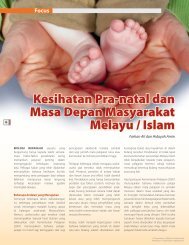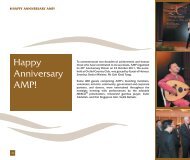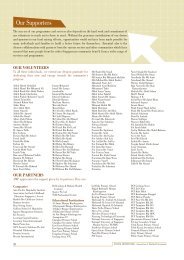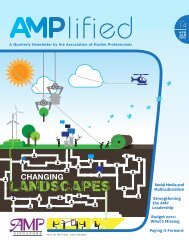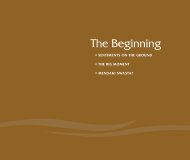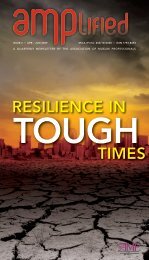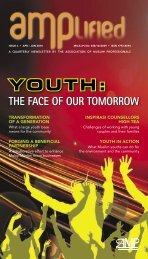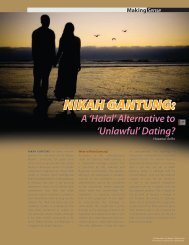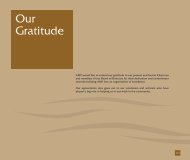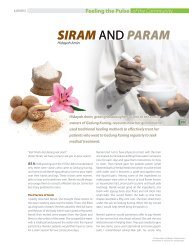©FA IN V10i2.indd - Association of Muslim Professionals
©FA IN V10i2.indd - Association of Muslim Professionals
©FA IN V10i2.indd - Association of Muslim Professionals
You also want an ePaper? Increase the reach of your titles
YUMPU automatically turns print PDFs into web optimized ePapers that Google loves.
FOCUSKARYAWANPhotos: © Singapore Press Holdings Limited. Reprinted with permission.4From top row, left, clockwise: Natasha Nabila Muhamad Nasir, Nazhar Adnan, Ainan Celeste Cawley, Muhammad Adib Surani, Muhammad Haikal Abdullah Zain and Pr<strong>of</strong>essor Ahmad IbrahimTIPP<strong>IN</strong>G PO<strong>IN</strong>T FOR THE MALAY COMMUNITY?Yang Razali KassimThe emergence <strong>of</strong> Muhammad Haikal Abdullah Zain as probably the first Malay genius is somethingto be proud <strong>of</strong>. Is this the beginning <strong>of</strong> more Malay child prodigies? Can the community develop astrategy to produce more Malay geniuses over the next two decades?<strong>IN</strong> MY BOOK, it was by far the biggest news about the Malay community in a long time. The Malay language daily,Berita Harian, was first out with it on 4 February, playing it, rightly, on the front page. The Straits Times, Singapore’smain English language daily, should have had it on the same day, but did not. It made up for this by running thenews the next day, also on the front page, but with a picture bigger than the one carried in Berita Harian. The storyis about Muhammad Haikal Abdullah Zain – probably the first-ever Malay boy genius.Haikal, the First Singaporean Boy Genius?Unless my memory fails me – and I stand corrected, <strong>of</strong> course – he may well also be the first-ever Singaporeanboy genius in his age group. At 13, he is qualified to enter university. He scored straight As in an examinationthat only 18 year-olds would sit for to enter university. His As were for Biology, Physics and Chemistry which he© <strong>Association</strong> <strong>of</strong> <strong>Muslim</strong> Pr<strong>of</strong>essionals. Permission is required for reproduction.
KARYAWANFOCUSscored by sitting for the British equivalent <strong>of</strong> the GCE ‘A’ level examinations – the International General Certificate<strong>of</strong> Secondary Education (IGCSE). He sat for it last November when he was 12. When I was his age, I was in Primary6 trying hard to get into Secondary One; entering university did not even cross my mind. And the faculty he isaiming for? Medicine – because he wants to study the human brain. It is an acknowledgement <strong>of</strong> his brilliance thatthe National University <strong>of</strong> Singapore says it is seriously considering his application. In Singapore, the norm is thatyou don’t get into university until you are at least 18, or 21 if you did your National Service.Haikal’s sterling achievement takes a notch higher what appears to be a growing trend <strong>of</strong> Malays/<strong>Muslim</strong>s achievingexceptional peaks in education in recent years. Though few and far between, it is a positive trend nonetheless.A few years ago, Natasha Nabila Muhamad Nasir topped the Primary School Leaving Examination (PSLE) at 294points out <strong>of</strong> a possible 300. That was the highest PSLE score in 17 years, according to the Ministry <strong>of</strong> Education.The norm for the top scorers for PSLE has been in the region <strong>of</strong> the 280s. Breaking the 290 barrier was, beyonddoubt, the dream <strong>of</strong> any Singaporean PSLE student. Who would have imagined that a Malay girl would achievethat – and by just six points short <strong>of</strong> a perfect score <strong>of</strong> 300. It will be tough to match her performance, though itwill be matched or broken one day. Will that future record-breaker be another Malay student?Haikal the boy genius himself scored 274 points for his own PSLE, but that did not stop him from going on tostrike out to achieve his dream. So what drove him to excel? Apparently, he decided to sit for the IGSCE to testhis own ability after being inspired by another boy genius, Ainan Celeste Cawley. Ainan was the seven-year-oldSingaporean boy with a Malay mother and British father who sat for the IGSCE for one subject – Chemistry – at ‘O’Level and passed.It is encouraging to note that Haikal is not alone as a child prodigy. According to The Straits Times, his sibling,Farhan, now a Primary 6 pupil at Rosyth, the same school as Haikal’s, also scored three A stars and one A in theIGSCE exams last year. Haikal and FarhanIt is encouraging to note that Haikal is notalone as a child prodigy.come from a middle-class family. Theirparents are both engineers; their motherwas a civil engineer until she decided to bea housewife to dedicate her time fully tothe family. So what’s their secret? Did theyadopt any special study methods for their children? What inspiration did they give to their children to become sobrilliant? Unfortunately, their parents seem to be shying away from the spotlight for now.5Malay Child ProdigiesThe sterling achievements <strong>of</strong> Haikal, Farhan, and Natasha Nabila, should make the Malay community proud,especially given the seemingly endless spate <strong>of</strong> disheartening news about low educational attainment within thecommunity. When reports about Ainan first surfaced to become the youngest person in the world to pass the GCE‘O’ Level chemistry examination, the community was pleasantly surprised. While Ainan’s mother is Malay, his fatheris not. But Haikal and Farhan, like Natasha Nabila, do not come from mixed parentage. And there were quite a fewmore such child prodigies who came from pure Malay parentage. Another example is Muhammad Adib Surani,the former Raffles Institution mathematics genius who migrated to Australia with his parents five years ago andtopped Australia in Mathematics for boys <strong>of</strong> his age. The Australian media described him as one <strong>of</strong> the top mathsbrains in Australia for his peer.Much earlier, in 1994, a Malay boy with an IQ <strong>of</strong> 172 entered junior college at 15 when the usual age is 17. NazharAdnan from Temasek Junior College was selected to join a space camp in the US organised by NASA – triggering inhim an ambition to be an astronaut. Then, there was another source <strong>of</strong> pride, Dr Mansoor Jalil, the Cambridge PhDholder who had earlier graduated with First Class Honours in Physics. Indeed, decades earlier, before Singaporebecame a nation-state, Ahmad Ibrahim emerged as the first Singapore Malay student to score a double first classhonours in law and economics from Cambridge in 1939. He later became a pillar in the Malay/<strong>Muslim</strong> communityas Singapore’s first Attorney General. He was also the brain behind the Administration <strong>of</strong> <strong>Muslim</strong> Law Act (AMLA)– that piece <strong>of</strong> legislation which till this day defines the legal superstructure governing the religious life <strong>of</strong> theMalay/<strong>Muslim</strong> community in Singapore. Pr<strong>of</strong>essor Ahmad Ibrahim later helped pioneer the growth <strong>of</strong> Islamic lawin Malaysia, where he migrated to, when the International Islamic University was set up in the 1980s.© <strong>Association</strong> <strong>of</strong> <strong>Muslim</strong> Pr<strong>of</strong>essionals. Permission is required for reproduction.
FOCUSKARYAWANI see one subtle difference in the new emerging breed <strong>of</strong> Malay prodigies: the new ones are making waves not justin qualitative terms but also quantum leaps in the field <strong>of</strong> knowledge. Adib was a mathematics genius ahead <strong>of</strong>not only his peers. He topped the field amongst students <strong>of</strong> his age in another country – Australia. Haikal too wasahead <strong>of</strong> his peers and tested his skills beyond his age group.What this means is that despite all its constraints and shortcomings, the Malay community can and do producegeniuses, and in different fields such as maths, science and law. Although these have emerged sparingly,the trend seems to be emerging. Have we reached a tipping point whereby such Malay success stories willappear in greater numbers and in more predictable flows? Can we systematically nurture this trend?Nurturing A TrendPerhaps, the time has come for the community to seriously consider a systematic process to nurture geniuseswithin the community, notwithstanding the debate over nature versus nurture. The dominant school <strong>of</strong> thoughtargues that geniuses emerge naturally. But increasingly, there is a view that child prodigies, like talent, can benurtured. The <strong>Association</strong> <strong>of</strong> <strong>Muslim</strong> Pr<strong>of</strong>essionals (AMP), as a movement <strong>of</strong> pr<strong>of</strong>essionals, should seriously considerdeveloping a nurturing strategy for the community. Hothousing, for example, should not be avoided like a dirtyword. Back in the 1990s, the idea <strong>of</strong> nurturing talent, or even geniuses, was discussed in AMP. We called it ProjectAhmad Einstein, reflecting the combination <strong>of</strong> two objectives: Brilliant Malay/<strong>Muslim</strong> students, steeped in Islamicvalues to motivate and drive them.The project however did not take <strong>of</strong>f the ground because some in the community were averse to what they sawas ‘elitist’ ideas. If only we had gone ahead to develop a cohort <strong>of</strong> ‘Ahmad Einsteins’, we could have seen the resultsby now – in one generation.6The community needs to study how other countries develop prodigies – perhaps even other minoritycommunities with such programmes. This strategy <strong>of</strong> developing geniuses could be pursued in the context <strong>of</strong>a larger plan <strong>of</strong> role-playing within the community. As a community, our overall agenda remains the enduringgoal <strong>of</strong> how to achieve socio-economic progress as an integral component <strong>of</strong> the Singaporean nation-state.Our key goal is still how to tackle the problem <strong>of</strong> relative lack <strong>of</strong> progress in the areas <strong>of</strong> education, socialdevelopment and economic status. Over the next 10 years, the environment can be expected to be morecomplex as the economy is further transformed to meet the challenges <strong>of</strong> a more demanding world.AMP and CLF: Role SpecialisationOur expanding social problems calls for key players within the community to close ranks and strategise in terms<strong>of</strong> role specialisation. More resources and brainpower should be poured into addressing our social quagmire.The Community Leaders’ Forum (CLF), <strong>of</strong> which AMP has been a member since the Forum was formed, can be aplatform for the community to rally around to achieve this purpose.At the same time, a few key players should specialise to build the ‘dynamos’ <strong>of</strong> the future. These dynamos – thegeniuses – will be our future leaders who will become the ‘engines’ <strong>of</strong> growth and the pathfinders into the 21 stcentury. AMP should play this nurturing role so that we can help produce more role models for the community. Asa movement <strong>of</strong> pr<strong>of</strong>essionals with many <strong>of</strong> the more successful members <strong>of</strong> the community, we have the naturalhabitat and resource base to play this role. We should grow this habitat through our network <strong>of</strong> fellowships <strong>of</strong><strong>Muslim</strong> pr<strong>of</strong>essionals so that as a movement <strong>of</strong> pr<strong>of</strong>essionals, we can inspire the younger generation within thecommunity with stories <strong>of</strong> success.The CLF should see this role by AMP as a complementary strategy. In other words, the CLF should be strengthenedto tackle the problems <strong>of</strong> the community at the mass level, which AMP can and should contribute to. At the sametime, AMP should dedicate its resources to thinking and planning long-range to develop future geniuses for thecommunity. Nurturing more Haikals or Muhammad Adibs, or Natasha Nabilas, should be part <strong>of</strong> AMP’s plan for itsThird National Convention <strong>of</strong> Malay/<strong>Muslim</strong> Pr<strong>of</strong>essionals to help take the community into the future.Yang Razali Kassim is former Chairman <strong>of</strong> AMP. He is currently Supervising Editor <strong>of</strong> Karyawan and Chairman <strong>of</strong> the AMPConvention Steering Committee.© <strong>Association</strong> <strong>of</strong> <strong>Muslim</strong> Pr<strong>of</strong>essionals. Permission is required for reproduction.



